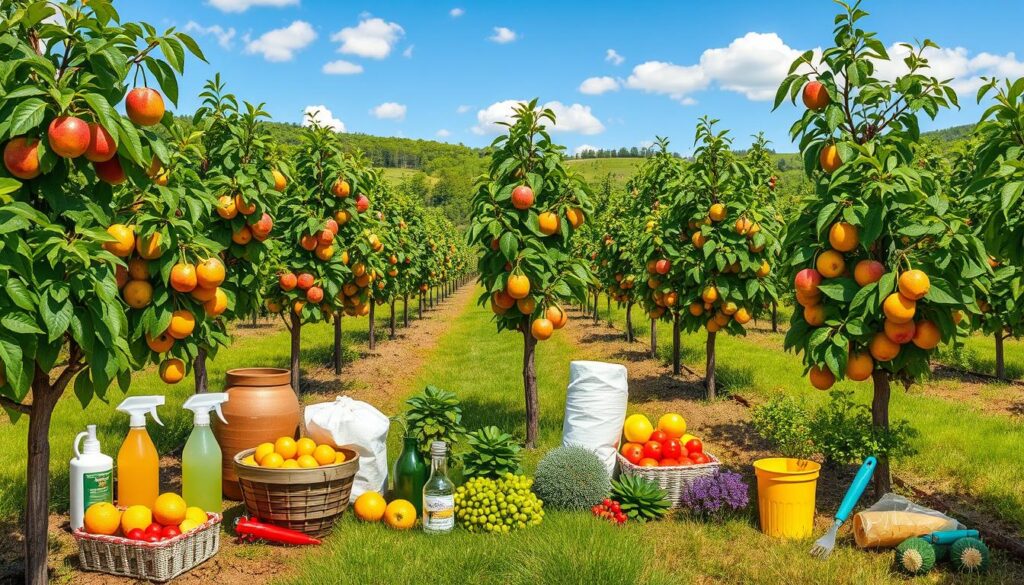Caring for fruit trees is more than just enjoying their fruits. It’s a big responsibility that needs attention and knowledge. Fruit tree diseases can harm their health and how much they produce. By learning to spot and treat common diseases, we can keep our orchards healthy and beautiful.
Knowing how to recognize symptoms early and treat them well is key. This helps our trees stay healthy for a long time. Without taking action, we might lose the many benefits these trees give us.
Key Takeaways
- Recognizing early symptoms is crucial for effective management of fruit tree diseases.
- Regular monitoring and care help ensure healthy fruit tree growth.
- Choosing disease-resistant varieties can significantly reduce the risk of infections.
- Maintaining proper orchard hygiene is essential in preventing the spread of diseases.
- Effective treatments vary and can include both organic and chemical solutions.
Introduction to Fruit Tree Diseases
It’s key to know about fruit tree diseases to keep orchards healthy. Diseases can ruin crops, affecting yield and fruit quality. Spotting and managing diseases early is crucial.
Many things make fruit trees more likely to get sick. Changes in temperature and more humidity are perfect for diseases, especially in wet seasons. If a tree gets sick, it can show many symptoms. Ignoring these can lead to big problems.
- Apples and pears can suffer from sooty blotch, bitter rot, and multiple forms of rot, like black rot and fire blight.
- Blueberries are not immune and may encounter botrytis blight or mummy berry.
- Brambles, such as raspberries and blackberries, face threats from diseases like anthracnose.
- Bunch grapes significantly struggle with black rot and powdery mildew.
To manage diseases well, using integrated pest management (IPM) is key. Choosing disease-resistant trees and keeping things clean helps a lot. Watching the weather and acting fast keeps trees healthy for a long time.
Understanding the Importance of Fruit Tree Health
Keeping fruit trees healthy is key for good fruit production and a healthy ecosystem. Trees that are well cared for can fight off minor diseases better. This makes them less likely to get seriously sick. Taking steps early on in tree disease prevention helps a lot.
Healthy fruit trees bring many benefits. They grow more fruit, and the fruit is bigger and more plentiful. They also fight off pests better, which means less need for harmful chemicals. This is good for the environment and makes the fruit safer to eat.
It’s important to catch problems early and take good care of trees. With the right watch and treatment, I can keep diseases under control. Guides like this one offer tips on keeping orchards healthy and spotting problems early.
How to Identify and Treat Common Fruit Tree Diseases
Knowing how to spot and treat common fruit tree diseases is key to keeping your trees healthy. Catching symptoms early is crucial. Regular checks are a must.
Recognizing Symptoms Early
Spotting symptoms early is vital for treating fruit tree diseases effectively. This way, I can tackle problems before they get worse. Look out for:
- Discolored leaves: Yellowing or browning can mean stress or infection.
- Lesions: Spotting or cankers often point to fungal or bacterial diseases.
- Abnormal fruit development: Misshapen or rotting fruit can signal health issues.
Peach leaf curl shows up in cooler weather, causing yellow leaves and loss. This shows why watching your trees closely is so important.
Common Signs of Disease Across Different Types of Fruit Trees
Different fruit trees show different disease symptoms. Here are some key diseases and their signs:
| Disease | Symptoms | Affected Trees |
|---|---|---|
| Peach Scab | Scab-like spots in cool, wet weather | Peaches, Cherries |
| Brown Rot | Rotting fruit during rains | Stone Fruits |
| Black Rot | Dark rot on fruit | Grapes |
| Bacterial Canker | Lesions and oozing resin | Peach, Nectarine, Plum |
Using products like Monterey Complete Disease Control or Bonide® Copper Fungicide can help manage these diseases. Organic solutions are better, as they keep trees healthy without harsh chemicals.

I also follow integrated pest management (IPM) guidelines. This method combines different approaches to keep trees healthy. I focus on prevention and early treatment to fight diseases effectively.
Learn more about this approach and its benefits here.
Overview of Common Fruit Tree Diseases
Fruit trees face many diseases that harm their health and growth. Knowing these diseases is key to keeping trees healthy. Spotting diseases early helps prevent big problems.
Peach Scab and Leaf Curl
Peach scab is caused by *Cladosporium carpophilum*. It makes leaves and fruit look bad. Leaf curl, common in peaches and nectarines, changes leaf shape and color.
Using fungicides early and keeping trees well-ventilated helps. This stops diseases from spreading.
Brown Rot
Brown rot is a big problem for stone fruits like peaches and plums. It makes fruit rot and turns brown. You’ll see gray fungus too.
Removing bad fruit and keeping orchards clean helps. This reduces the chance of brown rot.
Bacterial Canker and Black Rot
Bacterial canker hits cherry, peach, and apricot trees. It looks like dark spots on branches and trunks. It also causes branches to die and sap to ooze.
Choosing disease-resistant trees is a good start. Black rot, found in grapes and some trees, shows as dark spots. It’s important to watch for it, especially when it’s wet.
Methods for Fruit Tree Disease Identification
Identifying fruit tree diseases early is key to preventing them. A mix of methods works best for early detection. Visual checks are a mainstay. Looking at leaves, fruits, and trunks can spot diseases like Peach Leaf Curl or Sooty Blotch/Flyspeck.
- Local county cooperative extension services can help identify diseases.
- Guides that list symptoms for different diseases are also helpful.
- Diagnostic tools and apps can aid in visual checks.
- Tracking spring temperatures helps spot disease risks.
Watching the environment is crucial for disease spotting. Cool, wet springs are prime for fungal diseases. Knowing the weather helps spot at-risk trees.
Spotting diseases early means we can act fast. Knowing symptoms and using resources helps pick the right treatments. This can avoid big treatments later.
| Fruit Tree Type | Critical Temperature Range (°F) | Common Diseases |
|---|---|---|
| Apples | 28-32 | Fire Blight, Scab |
| Pears | 30-34 | Fire Blight, Sooty Blotch |
| Peaches | 25-30 | Bacterial Spot, Peach Leaf Curl |
| Sweet Cherries | 30-34 | Brown Rot, Gummosis |
| Tart Cherries | 28-32 | Black Rot, Cherry Leaf Spot |
Knowing these details helps manage fruit trees better. Spotting diseases early prevents damage. This leads to healthier, more productive trees.
Effective Fruit Tree Disease Treatment Options
Treating fruit tree diseases needs a mix of methods to keep your trees healthy and productive. Knowing the treatment options is key for fruit growers. I’ve found that using biological control and organic or chemical treatments together works best against common diseases.
Biological Control Measures
Biological control is a smart strategy. For example, introducing ladybugs can naturally control pests. These insects help in managing pests without needing a lot of fruit tree disease treatment. It’s also important to watch for diseases like sooty blotch and flyspeck on apples and pears. Catching these early makes control easier.
Using Organic and Chemical Treatments
Organic treatments add protection against diseases. Compost tea and baking soda can fight mildew. There are also OMRI-listed organic products for other diseases. These methods make preventing tree diseases more doable. Sometimes, chemical fungicides are needed. It’s important to pick the right fungicides and follow the label to keep the tree safe.

| Disease Type | Impact on Trees | Treatment Options |
|---|---|---|
| Peach Leaf Curl | Peach, Nectarine | Fungicidal sprays, biological control |
| Brown Rot | Apricot, Cherry, Peach, Plum, Nectarine | Organic treatments, timely pruning |
| Black Rot | Apple, Pear | Dormant sprays, fungicides |
| Gummosis | Peach, Nectarine, Plum | Sanitation practices, fungicidal treatments |
| Bitter Rot | Apple, Pear, Cherry | Routine monitoring, integrated management |
Combining prevention and timely treatments is key to managing fruit trees well. Keeping growing conditions right and staying updated on local diseases helps a lot. For more tips, check out a guide like the privacy policy for affiliate sites.
Preventing Fruit Tree Diseases
It’s key to take steps to prevent tree diseases for healthy fruit trees. I choose disease-resistant varieties that fit my climate and soil. This is the first step in caring for fruit trees.
Selecting Disease-Resistant Varieties
Choosing trees that resist common diseases is important. For example, some apple trees fight off apple scab and fire blight. This choice helps manage diseases.
Maintaining Orchard Hygiene
Keeping the orchard clean is also crucial. I remove fallen leaves, fruit, and debris to stop diseases. Proper pruning also helps by keeping air moving and preventing moisture buildup. These steps are essential for fruit tree care.
Best Practices for Ongoing Fruit Tree Care
Keeping fruit trees healthy needs regular and smart care. By using the right methods, I can make my trees live longer and grow more fruit. This also helps them fight off diseases and pests better.
The Role of Pruning in Tree Health
Pruning is key for healthy growth and more fruit. Cutting back trees every year keeps them strong and improves air flow. This cuts down on diseases. Knowing the right time to prune each tree type is also important:
- Apples and Pears: Prune in late winter when trees are dormant.
- Cherries: Best pruned in hot weather to prevent bacterial diseases.
- Peaches, Nectarines, and Apricots: Prune in early spring after the last frost.
- Plums: Require aggressive pruning to manage their vigorous growth; summer pruning can help contain their spread.
Good pruning also means cutting out branches that grow inward. This lets more light in.
Importance of Regular Monitoring
Watching my fruit trees closely helps me catch problems early. This early action is key to keeping them healthy. I look for signs of stress or disease:
- Signs of pests: Inspect for visible damage from common insect pests such as aphids or leafrollers.
- Fungal issues: Observe for signs of fungal growth, especially during wet weather.
- Nutritional deficiency: Yellowing leaves may indicate the need for proper fertilization.
Keeping a close eye, taking notes, and even photos helps me understand my trees’ health. Knowing about weather helps me prepare for challenges. This way, I can keep my trees and orchard healthy.
| Fruit Type | Best Pruning Time | Spacing Recommendations |
|---|---|---|
| Apples | Late Winter | 12-14 feet apart |
| Pears | Late Winter | 12-14 feet apart |
| Cherries | Hot Weather | 12-14 feet apart |
| Peaches | Early Spring | 12-14 feet apart |
| Nectarines | Early Spring | 12-14 feet apart |
Sticking to regular care boosts fruit tree health. This leads to more fruit and stronger trees that can handle tough weather.
Conclusion
Managing fruit tree diseases is key to keeping my orchard healthy and productive. Many pathogens, like bacteria and fungi, can harm my trees if not treated quickly. Spotting symptoms early helps me use the right treatments, like organic or chemical options, to fight off diseases.
Preventing tree diseases requires ongoing care. Regular checks help me catch any issues fast. By pruning infected branches, I not only fix problems but also help my trees grow better in the future.
With the knowledge I’ve gained, I can protect my orchard from diseases. For more tips on treating these issues, I can check out EyouAgro or Garden Beginner for advice on orchard care. Staying informed and proactive keeps my orchard thriving for years.





Leave a Reply